Storm of the Blue Line
prehistory
As a result of the onset of the spring-summer of 1943, the troops of the North Caucasus Front (NCF) came close to the heavily fortified Blue Line on the approaches to the Taman Peninsula.
At the end of April - in May 1943, Soviet troops tried to break through the enemy’s defenses and complete the liberation of the North Caucasus. Grechko’s 56th Army, after stubborn fighting, was able to take Krymskaya station, one of the Wehrmacht’s defense hubs. That's where the success ended.
In the area of the villages of Kyiv and Moldavanskaya, the Germans stopped the Soviet offensive. The Nazis, relying on a well-organized defense and using the support of a strong Luftwaffe group that operated from air bases in Crimea, repelled the offensive of the Red Army.
In April - June 1943, a fierce battle unfolded in the air over the Kuban between Vershinin's 4th Air Army and Richthofen's 4th Air Fleet. Soviet aviation was able to put an end to the dominance of the German Air Force.
In the summer, a favorable situation is developing for a new offensive in the Caucasus. Soviet troops defeated the Wehrmacht in decisive battles near Orel, Belgorod and Kharkov. Our soldiers broke through the German defenses on the Dnieper, Mius and Molochnaya rivers. The advance of the Red Army to the lower reaches of the Dnieper put the Taman enemy group in a difficult situation.
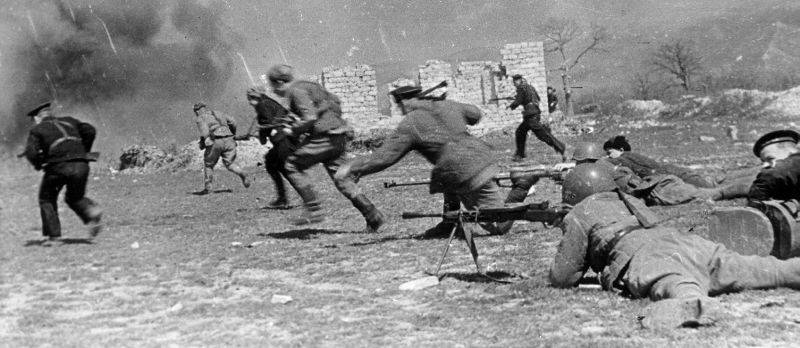
Marines of the Black Sea Fleet go on the attack near Novorossiysk. February-March 1943
"Blue Line"
The Taman bridgehead, which the German Headquarters initially needed as an area for a new offensive in the North Caucasus, lost its former significance. However, the Germans decided to hold it as long as possible and continued to strengthen the defense. Taman was needed to protect sea communications, as it constrained the actions of the Black Sea Fleet and covered the approaches to Crimea, the most important naval and air base of the Wehrmacht. Also, the German 17th Army pinned down a serious group of the Red Army, which could be used in an offensive in Ukraine.
Back in the winter of 1943, the Germans prepared a defensive line in the Krasnodar-Taman direction - the “Blue Line”. It was also called the defensive line “Gotenkopf” (Head of the Goth).
The terrain was very convenient for defense. In the northeast of the theater of military operations, off the coast of the Sea of Azov and the valley of the Kuban River, swampy lowlands prevailed with a significant number of floodplains, estuaries, rivers, rivers and streams. The southeastern section of the combat area is mountainous and forested. In the depths of the peninsula, from the Varenikovskaya and Anapa districts, the terrain was flat and steppe. From the line Temryuk, Blagoveshchenskoye, in the western part of the Taman Peninsula, troops could only advance along narrow defiles between estuaries.
This allowed the Germans to create a strong defense system, turning populated areas and some areas of the terrain into centers of resistance. The defense was also strengthened by the fact that the Germans had reduced the front, greatly condensing their defensive formations.
The Germans, with the help of slave labor from the local population, built several defensive lines with intervals between them from 5 to 25 km. The main defensive line, the Blue Line itself, had a depth of up to 6 kilometers. It consisted of three or four positions protected by minefields and several rows of barbed wire. But even behind it, at a depth of 30–40 km, there were auxiliary well-prepared defensive lines.
The central section of the Blue Line, 32 km long, was most convenient for the Russian offensive, and the Germans paid special attention to strengthening it. There were two positions with a large number of resistance nodes and strongholds. The villages, farmsteads and dominant heights were prepared for long-term defense. They tried to cover the gaps between them with reinforced concrete firing points with armored caps.
The main points of resistance in the first line of defense were the village of Kievskoye and the height at 195.5. Kyiv closed the path to Taman through the village of Varenikovskaya, and height 195.5 closed the highway and railway through the villages of Nizhne-Bakanskaya and Verkhne-Bakanskaya, which went to Novorossiysk. The most powerful defense center of the second position was created in the village of Moldavanskaya, which was located in the center of a hilly plateau. It was supposed to close the path to the center of Taman in the event of a breakthrough by Soviet troops to the forward position.
The southern flank of the Blue Line passed through an inaccessible mountainous and wooded area 25 km long from the village of Neberdzhayevskaya to Novorossiysk. Here the German defense was based on forest debris, anti-personnel mine-explosive barriers and combined with a system of multi-tiered fire.
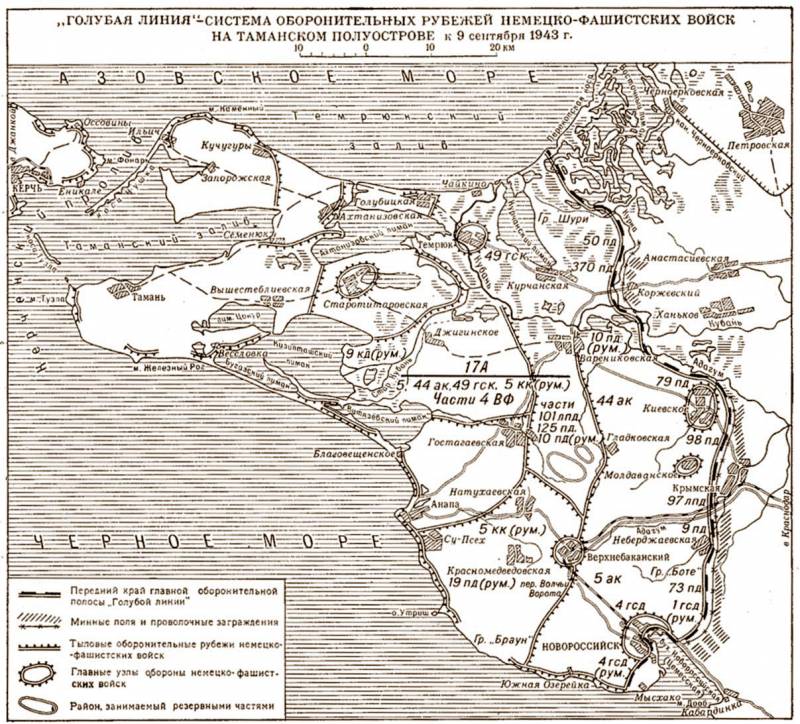
One of the most powerful centers of enemy resistance was the part of Novorossiysk captured by the Germans, the approaches to the city, as well as positions in the Myskhako area, where there was a Soviet bridgehead. Over the course of a year, day and night, the Germans created a system of defensive structures in Novorossiysk. To combat possible Soviet landings, a strong anti-landing defense was created. The entire coastline up to Anapa and beyond was prepared to repel the Russian landing.
The Soviet troops were opposed by the 17th Army under the command of Erwin Gustav Jenecke. She was part of Army Group A. The 17th Army included formations of the 5th, 44th Army Corps, 49th Mountain Corps, and Romanian Cavalry Corps. A total of 17 infantry, mountain rifle and cavalry divisions, 4 separate regiments and several other separate formations. The German-Romanian troops numbered 200 thousand people (according to other sources, about 400 thousand), 2 guns and mortars, 860 tanks and assault guns and about 300 combat aircraft. The reserve of the 17th Army was located in Crimea - over 95 thousand people (including training units and allied troops).
In the first echelon on a 100-km front, 12 divisions held the defense, in the second - 5. The German forces were unevenly distributed, because the Nazis were most worried about the central section of the defense, since on the left wing there were inaccessible Azov floodplains, where the attackers could get stuck in the swamps , and on the right is the powerful Novorossiysk fortified area and the dominant heights. The Red Army could not use armored formations on the flanks. Therefore, there were three divisions in front of the Soviet 9th Army on a front of 40 km; in the sector of the 56th Soviet Army on a front of 30 km, 5 enemy divisions held the defense; the remaining German divisions held the defense against the 18th on a front of 29 km.
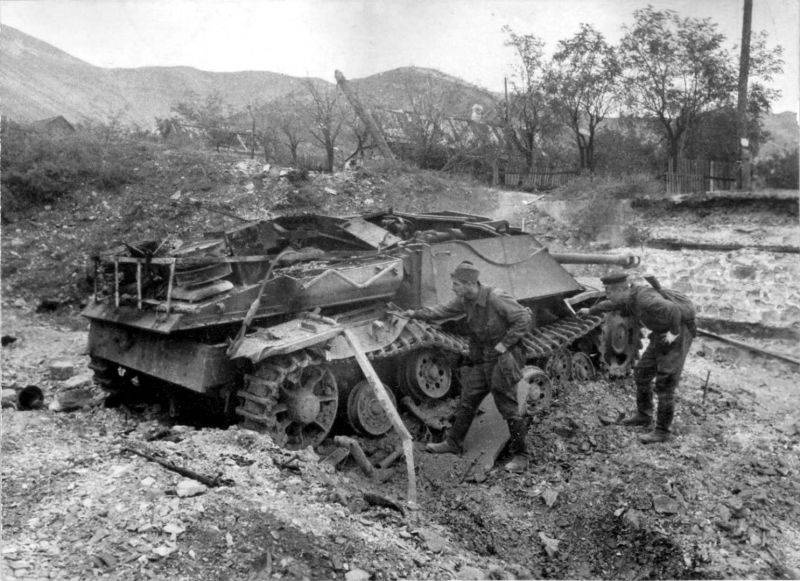
German assault gun StuG III Ausf. G, shot down in the village of Stanichka in the Novorossiysk region. September 1943
Preparation of the operation
In August 1943, the Soviet Headquarters instructed the commander of the SKF Petrov to destroy the Taman group of the Wehrmacht, preventing its withdrawal to the Crimean Peninsula. The Soviet command believed that the enemy did not expect an attack in the Novorossiysk direction, where it was most difficult to attack, and somewhat weakened its right flank. Therefore, it was decided to deliver the main blow in the Novorossiysk area.
The breakthrough of the German defense in the Novorossiysk direction, the capture of the Neberdzhaisky and Volchi Vorota passes, disrupted the entire enemy defense system, creating the possibility of encirclement and complete defeat of the Taman group. Also here it was possible to use the fleet in an offensive.
The troops of Grechkin's 9th Army, in cooperation with the forces of the Azov flotilla of Rear Admiral Gorshkov, were to conduct an offensive along the river. Kuban to Kurchanskaya, Temryuk and Varenikovskaya. Grechko's 56th Army advanced in the Moldavanskaya area towards Gladkovskaya and Gostagaevskaya. The 56th Army with its right wing was supposed to strike at Varenikovskaya. Leselidze's 18th Army, in cooperation with Vladimirsky's Black Sea Fleet, delivered the main blow to Novorossiysk and developed it in the direction of Verkhnebakanskaya and Anapa.
The SCF command planned to cut through the German defenses, quickly reach the crossings of the Old Kuban River and cut off the enemy’s escape route to the ports and the Kerch Strait. Preparations for the operation were planned to be completed by September 7. The start of the offensive by the main forces of the 9th and 56th armies depended on the success of the troops of the 18th Army in the Novorossiysk direction. Until this moment, starting from September 5, they had to carry out local operations using small detachments and divert the enemy’s attention to themselves.
The SCF included the 58th, 9th, 56th, 18th and 4th Air Armies (plus the Black Sea Fleet aviation). Three armies took part in the operation: the 21st Rifle and Mountain Rifle Division, several separate rifle and tank brigades, separate tank regiments, and reinforcement artillery. Units of the 58th Army were involved in the defense of the Azov Sea coast. The total number of troops was more than 315 thousand people, 4 guns and mortars, more than 435 tanks and self-propelled guns. The Soviet front was almost 300 times superior to the enemy forces in infantry and artillery, and had an advantage in armored vehicles.
Aviation had a significant advantage. As a result of large losses in air battles on the Kursk Bulge and Kuban, the number of German Air Force combat aircraft fell. In total, the Luftwaffe had 1 aircraft in the southwestern direction, of which about 275 were based in Crimea and Taman. By the beginning of the Novorossiysk-Taman operation, Vershinin’s 300th Air Army had about 4 combat aircraft. In addition, the Black Sea Fleet Air Force had up to 600 aircraft. Air superiority became a serious prerequisite for the success of the offensive.
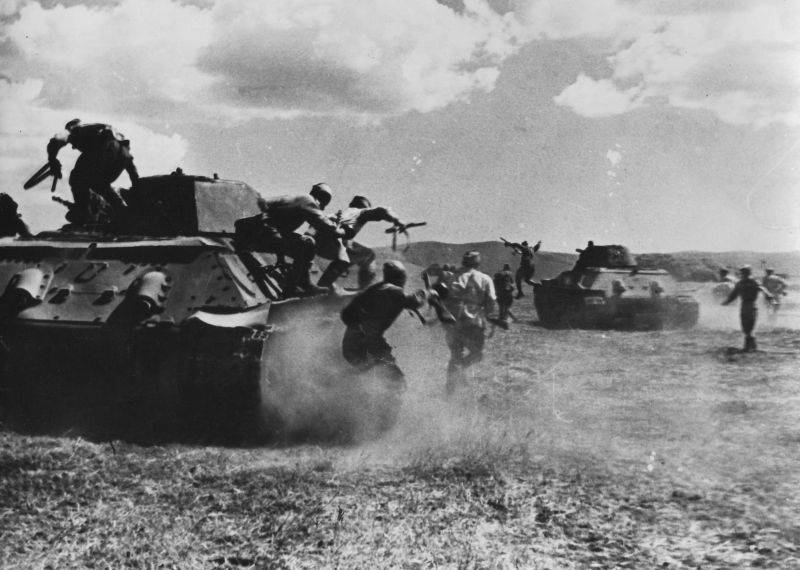
The 2nd Guards Rifle Division is storming the German Blue Line fortifications on the Taman Peninsula. For the liberation of the Taman Peninsula, the 2nd Guards Rifle Division received the honorary title “Tamanskaya” on October 9, 1943.
Novorossiysk operation
The most important part of the entire SCF operation was the Novorossiysk offensive operation. At the end of August 1943, the command of the 18th Army and the Black Sea Fleet was given the task of liberating Novorossiysk and developing an offensive in the direction of Verkhnebakansky.
The operation involved the forces of the 89, 176 and 318 rifle divisions, the 83 th naval rifle brigade and the 255 th brigade of the Marine Corps, the 8 th Guards and the 107 th, 81 th Rifle Brigades and 290- of the rifle regiment of the NKVD. Amphibious detachments of the Black Sea Fleet supported them from the sea. Converging attacks on the Novorossiysk grouping of the enemy were inflicted by the Eastern Group of Forces and the Western Group of Forces (from the Myskhako bridgehead). In the port of Novorossiysk, they planned to land a landing party, which was to hit the rear of the German troops, who were beating off the attack of the Western and Eastern groups of the 18 Army.
The Eastern Land Group included the 318th Rifle Division of Colonel Vrutsky (without the 1339th Rifle Regiment, it was involved in the landing), reinforced by an assault detachment of the 55th Guards Rifle Division and eight tanks. Vrutsky’s group received the task, with the support of a landing force landed in Tsemesskaya (Novorossiysk) Bay, to break through the German defenses in the area of the Oktyabr cement plant. Then units of the 318th Infantry Division, in cooperation with their 1339th Regiment (it constituted the third landing detachment), were to liberate the area of the Proletary cement plant from the Germans and capture the village of Adamovich Balka. In the future, the Eastern Group was supposed to develop an offensive on the Methodius suburb and the Markotkh pass.
Shvarev's western group of troops attacked from the Myskhako bridgehead. The 83rd separate naval and 8th guards rifle brigades were supposed to capture the western part of the city (height 307.2). The Western Group's offensive was supported by Amphibious Detachment No. 1, which included the 255th Naval Rifle Brigade. The first landing detachment landed on the southwestern shore of Novorossiysk Bay. Subsequently, the Western Ground Group and paratroopers, in cooperation with other groups, were to completely liberate the city.
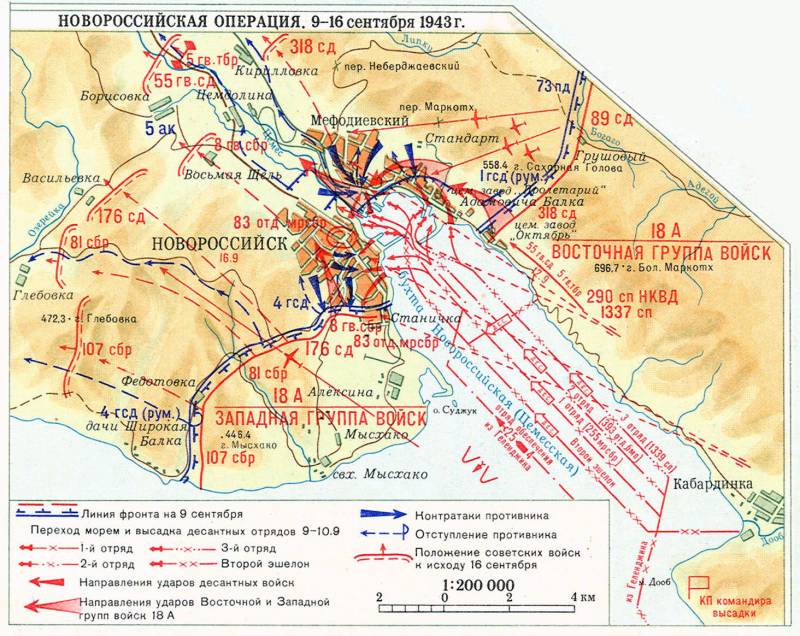
The Marine Landing Group, under the command of the commander of the Novorossiysk naval base, Rear Admiral Kholostyakov, included: the 255th Marine Brigade, the 393rd Separate Marine Battalion (second detachment), the 290th NKVD Regiment and the 1339th Regiment of the 318th rifle division. A total of 6 soldiers and commanders. The airborne troops were armed with 480 guns, 41 mortars and 147 heavy machine guns. Each paratrooper had anti-personnel and anti-tank grenades.
The landing group was divided into three separate detachments, each with its own task. Colonel Potapov's first detachment as part of the 255th Marine Rifle Brigade was supposed to operate together with the Western Group. The paratroopers were given the task of occupying the western shore of the bay in the area from Kholodilnik to Cape Lyubvi, and then advancing through the center of the city and capturing height 307.2.
Landing Detachment No. 2, under the command of Lieutenant-Commander Botylev, as part of the 393rd Separate Marine Battalion and the 290th Infantry Regiment of the NKVD (the second echelon of the landing force) was tasked with landing in the port and capturing the northern shore of the port from the Staro-Pasazhirskaya pier to Lesnaya. Then the paratroopers had to take possession of the railway station. Advance towards the northwestern outskirts of Methodius, establish contact with the first detachment.
Landing Detachment No. 3 of Lieutenant Colonel Kadanchik, as part of the 1339th Infantry Regiment, was supposed to seize a bridgehead in the eastern part of the port from the Eastern Pier to the Staro-Passenger pier. Then strike in the rear of the German troops, helping the Eastern Group of Forces defeat enemy forces in the area of the Proletary cement plant, the village of Adamovich Balka and the Mefodievsky suburb.
For the landing of the forces of three detachments, the Black Sea detachment allocated 148 combat and auxiliary boats, motor and rowing longboats. They were divided into three detachments of landing ships. The first detachment of landing ships under Lieutenant Commander Derzhavin had 59 units and was divided into three groups. The second detachment of landing ships of Lieutenant Commander Glukhov included 18 boats, and the third, under the command of Captain 3rd Rank Masalkin, had at its disposal 26 units of watercraft, divided into two groups.
They also formed a detachment to support the landing of the Marine Landing Group under the command of Captain 2nd Rank Protsenko. The support detachment consisted of 37 boats, of which 32 were torpedo boats. The detachment was supposed to ensure the success of the landing operation. It consisted of four groups: breakthrough, coastal attack, port attack and a group covering the operation from the sea. At the same time, a fire assistance detachment was formed, which included three destroyers.
The operation was supported from the air by 148 aircraft of the Black Sea Fleet and the 4th Air Army. To break through the German defense and support the landing, the 18th Army, in addition to the existing combined arms artillery, received 8 reinforcement artillery regiments, one artillery brigade of 203 mm guns, one mortar regiment, 6 guards mortar regiments, one heavy guards rocket artillery brigade and 47 Black Sea coastal guns fleet.
In total, the army command had about 800 guns and mortars at its disposal. Also, 227 installations of guards mortars were concentrated at the breakthrough site.
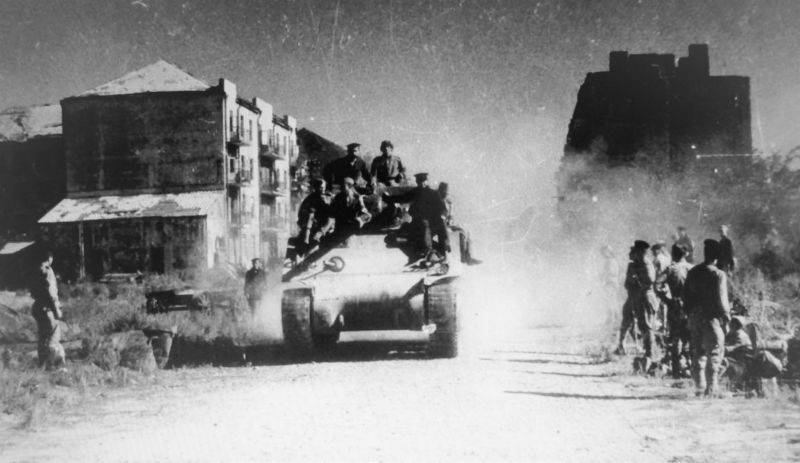
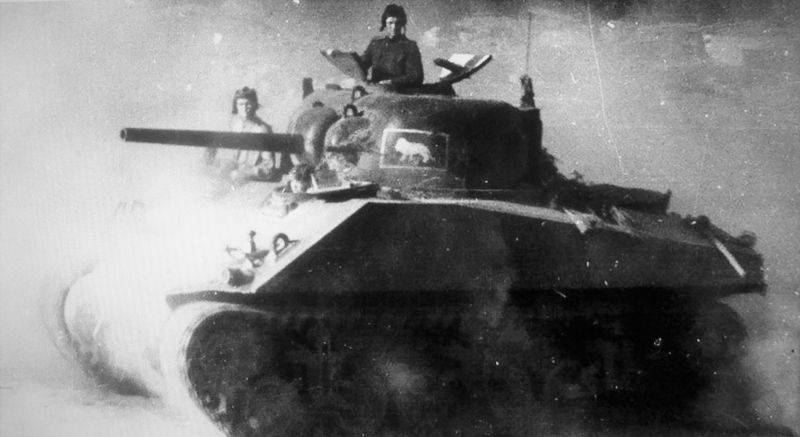
An M4A2 tank (Sherman, American-made) from the 5th Guards Tank Brigade of the Red Army drives through liberated Novorossiysk
Assault
On the night of September 10, 1943, the operation began. By 21 o'clock the first and second landing detachments boarded ships and went to sea. At 2 hours 44 minutes all units took up their starting positions. Aviation and artillery began to launch massive attacks on enemy positions. 800 guns and mortars brought down a barrage of fire on enemy positions.
The Germans were taken by surprise. They didn't expect this blow. Fires started in the city. The smoke from them helped to camouflage the landing. The Germans quickly recovered from the first shock and returned fire from 40 artillery batteries and six-barreled mortars.
The boats of the breakthrough group made their way to the piers, destroying booms and mines at the entrance gates of the port. A shore attack group followed them, hitting enemy firing points on the shore and piers. Soviet torpedo boats destroyed about 30 enemy pillboxes and bunkers near the coastline. Then they quickly landed assault groups on the Western and Eastern breakwaters, which gave signals that the way was clear.
Everything happened very quickly.
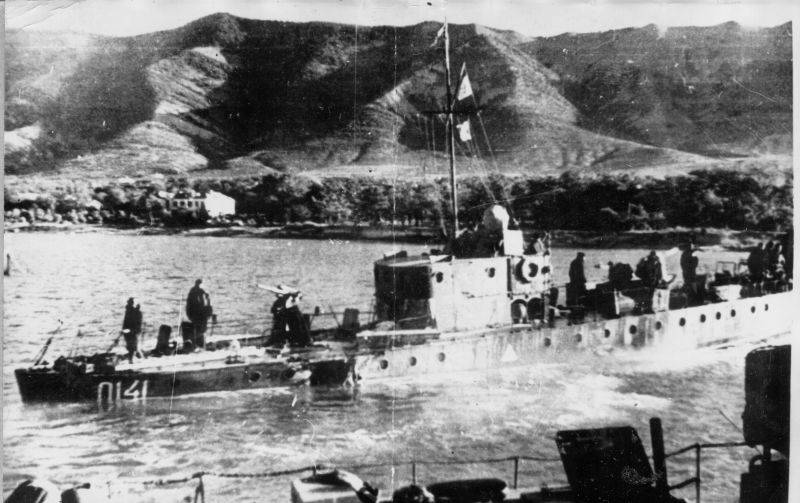
Soviet boat SKA-0141, damaged during the Novorossiysk landing operation
Already at 2 hours 56 minutes, the boats of the port attack group burst into the port and began to strike enemy firing points on the piers and on the shore at the landing sites of the landing groups. At this time, German artillerymen rained fire on the entrance gate to the harbor. Their width did not exceed 80 meters. The first to burst into these gates were the paratroopers of the second detachment - the 393rd separate battalion of the Marine Corps. In 20 minutes, landing ships and vessels landed about 800 soldiers. The battalion was armed with 10 mortars, 19 heavy machine guns and 40 anti-tank rifles. The landing took place at the Elevatornaya and Neftenalivnaya piers. The Marines immediately captured several piers in the northwestern part of the port.
The fighters of the first and third detachments began to land behind the second detachment. In 30 minutes, more than 1 thousand people from the 1339th regiment (third detachment) landed at the Importnaya pier and at the power plant. They were able to unload several 45 mm guns, 20 mortars and 10 heavy machine guns.
The first landing detachment (the first echelon of the 255th brigade) faced serious difficulties.
The Marines encountered heavy artillery and mortar fire. In addition, the shallow depth at the landing site - at the Kabotazhnaya pier and on the coast from Cape Lyubvi to the root of the Western Pier - prevented the ships from coming closer. People had to be put on boats, motorboats and motorized launches. The landing took up to 4 hours and 25 minutes. The Germans sank some of the ships. Many ships that returned to Gelendzhik were seriously damaged and needed repairs.
As a result, the first detachment landed scatteredly and suffered heavy losses. Having used up all the ammunition, the soldiers of the 255th Naval Brigade on the night of September 11 broke through to the troops of the Western Group, who were trying to break through the enemy’s defenses in the Stanichka area.
The landing operation resulted in the creation of two small and isolated bridgeheads.
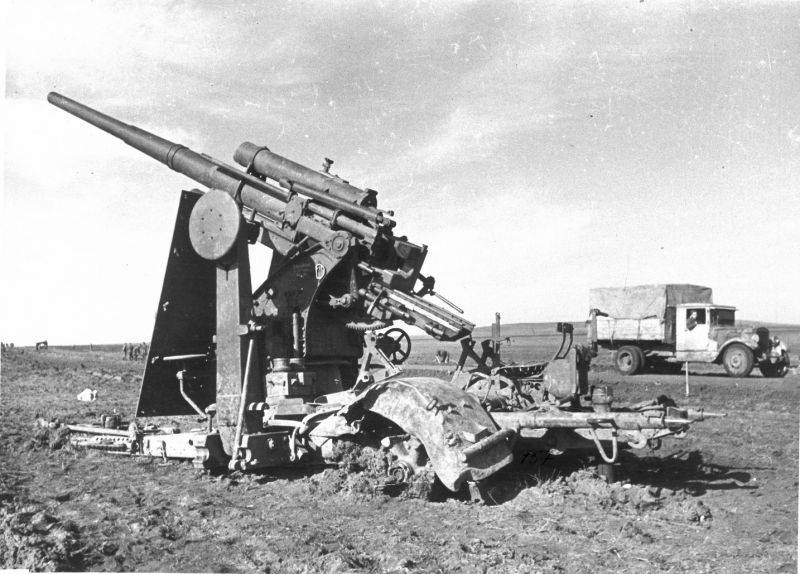
German anti-aircraft gun Flak 18, destroyed near Novorossiysk
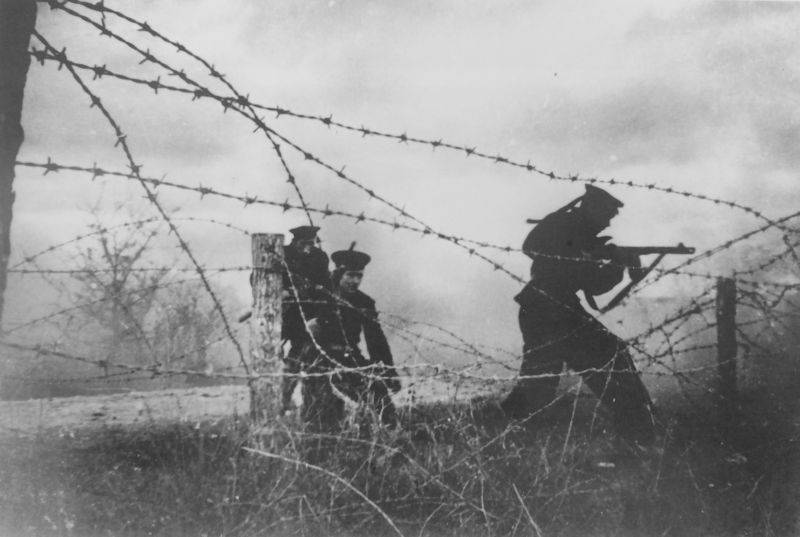
Black Sea paratroopers overcome a wire fence during the battle for Novorossiysk
"Black Death"
Simultaneously with the paratroopers, the Eastern and Western Groups of Forces began their offensive. They advanced from the Oktyabr cement plant and from the Myskhako bridgehead. The Germans had been preparing defenses in these directions for many months and were waiting for an attack here. Therefore, although fierce fighting took place here throughout September 10, Soviet troops were unable to break through the German defenses. Having recovered from the first blow, the Germans counterattacked with tank support.
The 2nd Airborne Detachment, showing miracles of courage and self-sacrifice, developed the offensive. The 393rd separate marine battalion was formed from soldiers of the legendary detachment of Major Kunikov, who landed in the Stanichka area in February 1943. Many Marines were participants in previous brutal battles for Novorossiysk.
These were the fighters whom the Germans called the “Black Death” with fear and respect. They fought for their hometown, for the largest base of the Black Sea Fleet, which it was an honor for them to defend. Marines made their way to the embankment and stormed the Sailors' House and club. At dawn, the Marines captured the station. The squad leader, Smorzhevsky, hoisted the Soviet Naval flag on it.
In the area of the power plant, soldiers of the 1339th Infantry Regiment fought heroically. The enemy turned the power plant building into a powerful stronghold. From the area of the power plant it was possible to view and fire at almost a third of the city. The Germans brought up reinforcements and surrounded the landing party. The 1339th regiment fought surrounded.
The Nazis, realizing the danger posed by Russian forces in the rear of their defense and in the city center, threw almost all their reserves into battle. By the end of the day, the Nazis pressed the landing forces to the sea. The German reserves consisted of various units of the 101st Light Infantry, 9th, 73rd and 125th Infantry Divisions.
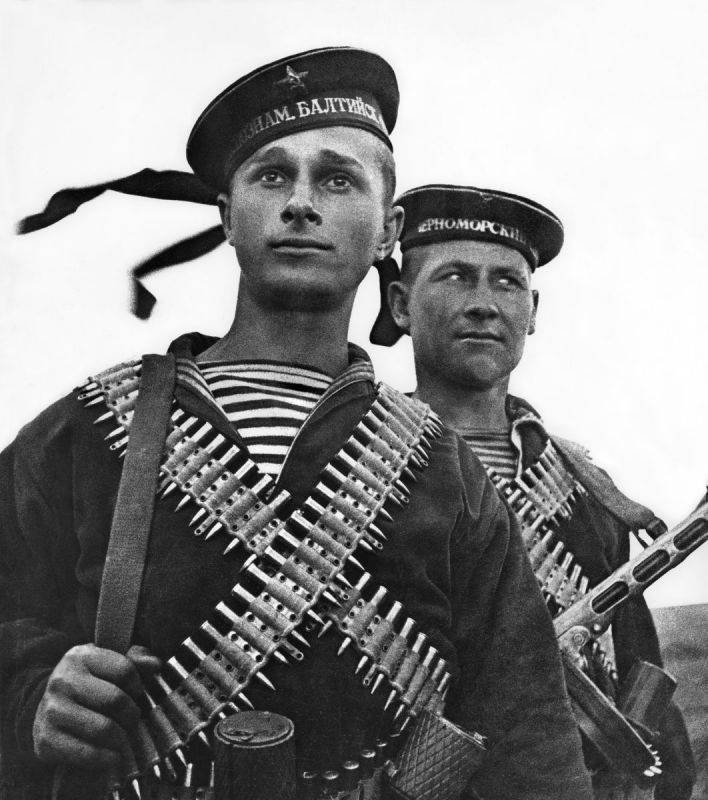
Two Marines of the Black Sea Fleet with PPSh submachine guns and RGD-33 grenades. Author's photo title: “They were twenty years old”
Breakthrough enemy defenses
Taking advantage of the fact that the enemy's main attention was focused on the landing, units of the 318th Infantry Division were able to achieve some success in the area of the enemy stronghold on Mount Sugar Loaf. Army commander Leselidze, seeing that a critical moment was approaching in the battle, decided to transfer the 1339th regiment - the 1337th regiment of Lieutenant Colonel Bulbulyan - to the aid of the 11th regiment. On the night of September XNUMX, the landing force went to sea.
By this time, the Germans had completely blocked the 1339th Regiment, recaptured the piers and piers, and hastily strengthened them. As a result, the 1337th regiment had to solve a difficult task - to land on a heavily fortified bank and relieve the encircled.
The Soviet riflemen fought their way through heavy enemy fire, landed on the shore and began their offensive. Soon the shooters linked up with the Marines of the second landing detachment in the area of the port workers' club.
The front command, realizing that the forces of the 318th division were not enough to break through the enemy’s defenses, transferred Arshintsev’s 55th Guards Irkutsk Division and Shurenkov’s 5th Guards Tank Brigade from reserve. At the same time, the actions of artillery and aviation were adjusted. All the power of the artillery was concentrated on the German resistance centers in the area of the cement plant and Sugar Loaf Mountain. The aviation group was strengthened. The 9th Army was supposed to launch an offensive on September 11 to divert the German army reserves.
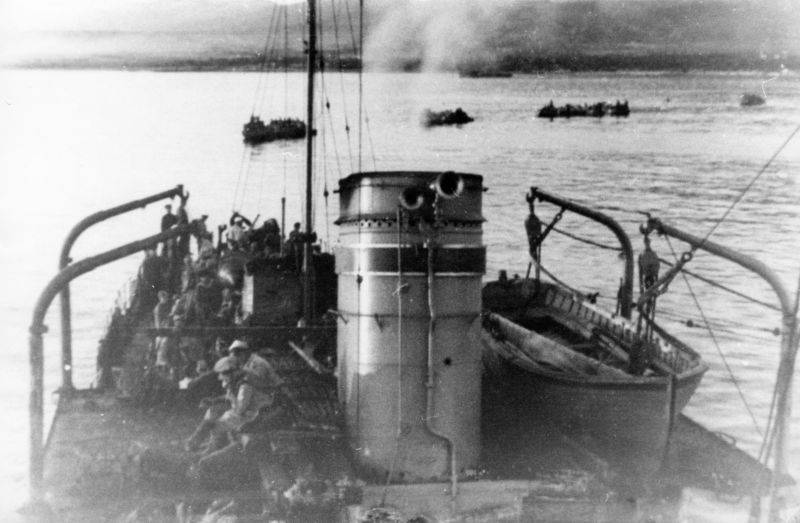
Soviet high-speed minesweeper T-406 type "Fugas" (project 53) "Iskatel" ensures the landing of one of the amphibious assault forces during the Novorossiysk-Taman offensive operation
Soldiers of the 383rd Engineer Battalion erected a stone lintel across the Kamyshovskaya beam. Tanks entered the battle. The 318th Division broke enemy resistance in a night battle and on the morning of September 11 united with units of the 1339th Infantry Regiment. By lunchtime, Soviet troops captured the area of the Red October cement plant, the village of Turkish Garden, a power plant, and the Proletary cement plant.
On September 12–13, the Soviet command introduced second echelons of landing forces into battle. The 393rd separate battalion of marines and part of the 290th NKVD rifle regiment fought heavy battles in the area of the station and elevator. The Germans, with the support of tanks, launched counterattacks and fought fiercely and skillfully. On the morning of September 13, the 55th Guards Rifle Division entered the battle.
The Germans tried to concentrate forces in the area of Sugar Loaf Mountain (up to two infantry regiments, 20 tanks, a division of assault guns) and, with a strike in the direction of the Oktyabr cement plant, close the gap, cut off and destroy the advanced units of the 318th Rifle and 55th Guards Divisions.
The Soviet command guessed the enemy's plan. The main forces of the 318th division turned to the northwestern direction, towards the Markotkh and Neberdzhaevsky passes, in order to reach the rear of the Germans. This decision prevented the enemy's flank attack on the Eastern Group.
At the same time, to develop success, the Soviet command concentrated a strike force in the area of the Oktyabr cement plant. It included units of the 5th Guards Tank Brigade, one self-propelled gun regiment, one anti-tank artillery regiment, and one engineering battalion. They were supposed to build on the success of the 318th Rifle and 55th Guards Divisions. At the same time, units of Kurashvili’s 414th Infantry Division began to be transferred from the front reserve to the battle area.
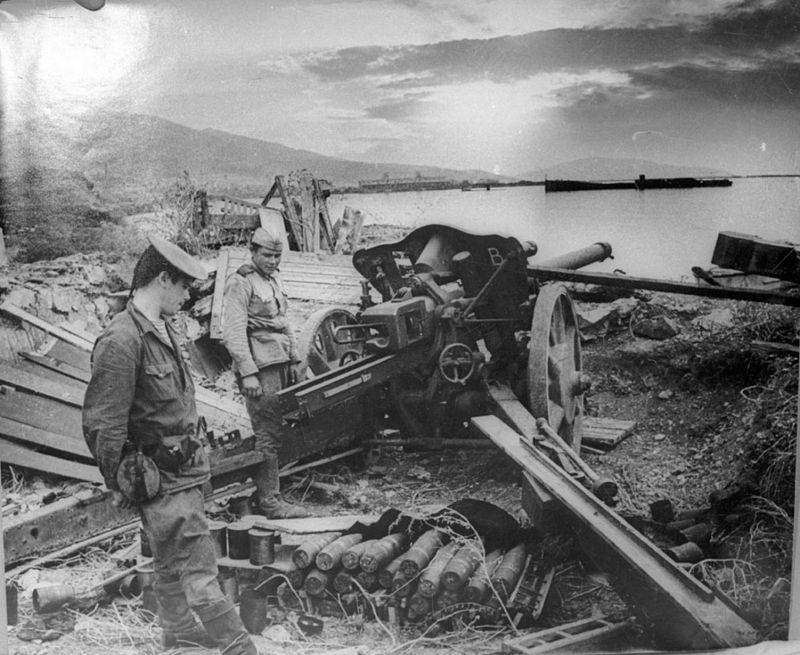
Sailor V. Kuzmenko and a Red Army soldier near the leFH18 howitzer abandoned in Novorossiysk
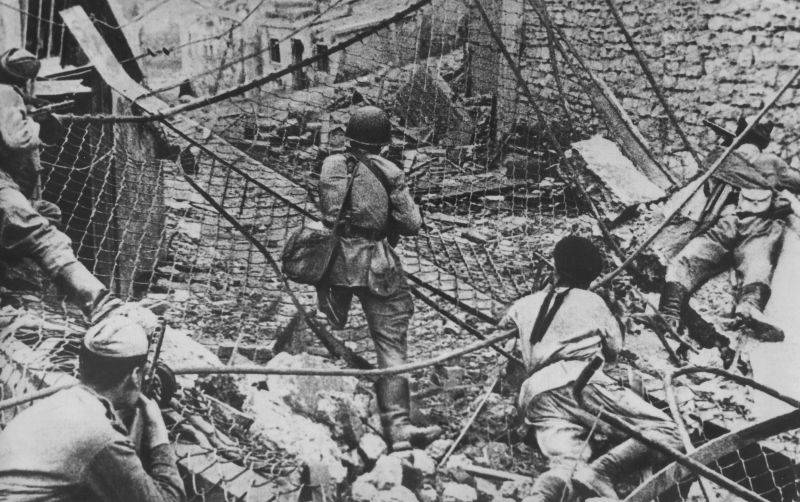
Submachine gunners of the 318th Guards Rifle Division in battle on the street of Novorossiysk
Liberation of the city
The enemy's resistance weakened. The Germans suffered heavy losses, tactical reserves were used up. There were practically no operational reserves. It was impossible to transfer reinforcements from other sectors of the front; the 9th and 56th Soviet armies began to attack.
On September 56, the 14th Army attacked Kievskoye and Moldavanskoye and Nizhne-Bakansky. The Novorossiysk Wehrmacht group was threatened with encirclement. Units of the 18th Army reached the Markotkh pass. The strike force of the 18th Army, together with units of the 55th Guards Division, broke the enemy’s defenses in the area of the station and began moving in the direction of Tsemdolina. On September 15, stubborn fighting continued. The Germans put up fierce resistance and counterattacked. Soviet troops continued their offensive. Soldiers of the 55th Guards Division went to the area of the elevator, train station, oil tanks, pier No. 5, and linked up with the Marines of the 393rd separate battalion. On the same day, the Western Group of Forces began to push back the Germans and advanced 1,5–2 km.
The German 4th Mountain Division was under threat of encirclement. By the evening of September 15, the Germans began withdrawing troops to the west and northwest. At night our troops cleared the southern part of the city. In the center, units of the 55th Guards, 318th and 414th Rifle Divisions had completely cleared the port and northern part of Novorossiysk of Germans by 10 a.m. on September 16th. Developing the offensive, by the end of the day Soviet troops were fighting for the Neberdzhaisky pass, Kirillovka, and Tsemdolina. The advanced units of the 176th Infantry Division and the 81st Infantry Brigade of the Western Group reached the line of Borisovka, Vasilyevka and Glebovka.
On September 16 at 20 o'clock Moscow saluted with twelve artillery salvoes from 124 guns in honor of the valiant troops who liberated Novorossiysk.
The ships of the Black Sea Fleet also fired a twelve salvo salute in honor of the liberation of the second base of the Black Sea Navy.
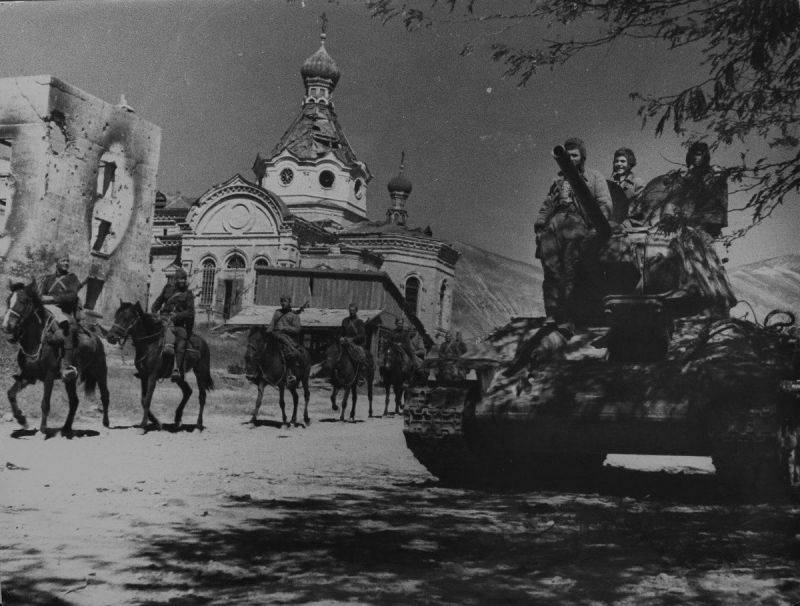
Mounted soldiers of the Red Army drive past a T-34 tank along the street of liberated Novorossiysk. September 16, 1943
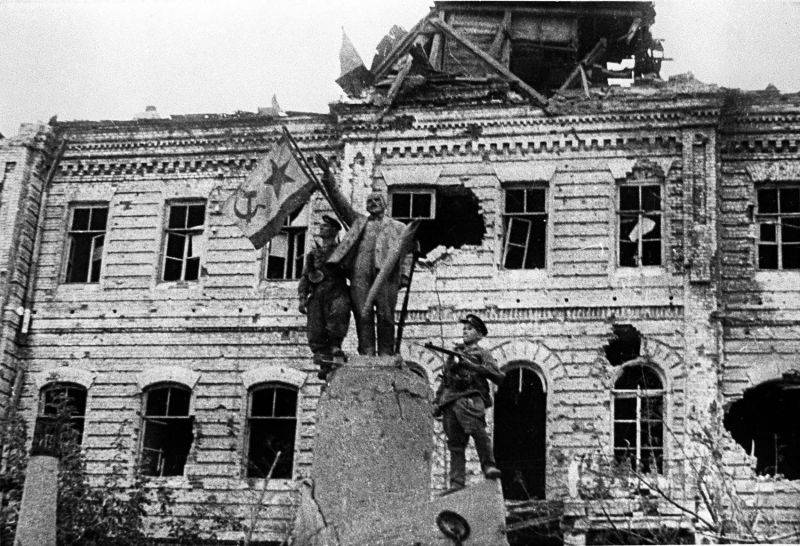
Red Navy men hoist the flag of the USSR Navy at the seaport building after the battle for Novorossiysk
To be continued ...
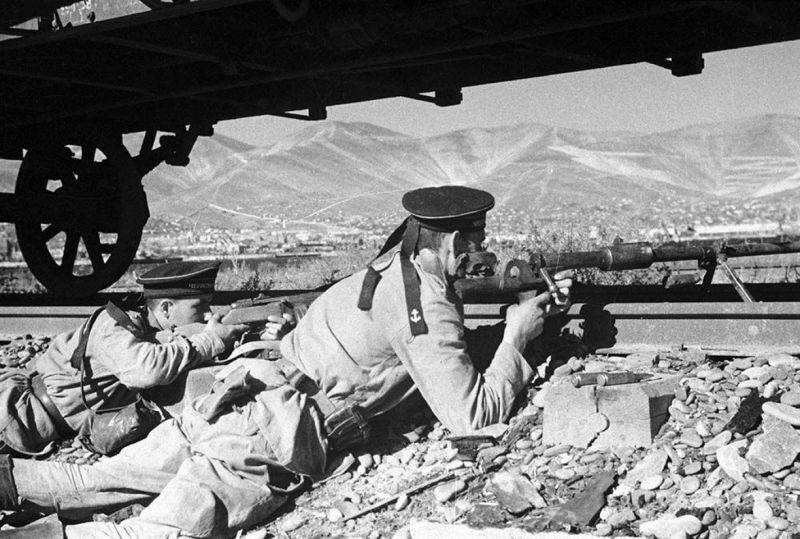
Information